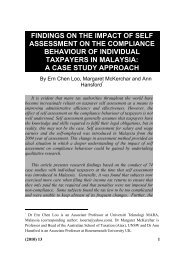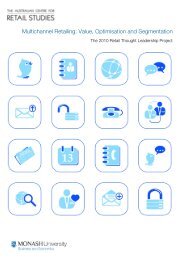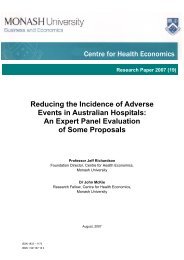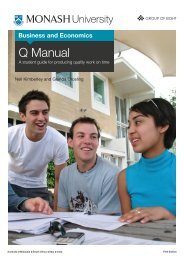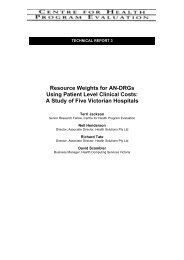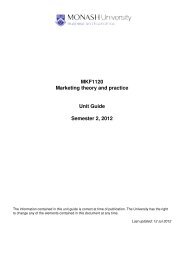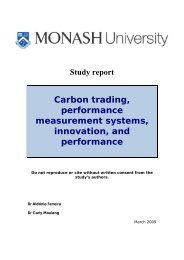Koong Seow Shin - Faculty of Business and Economics - Monash ...
Koong Seow Shin - Faculty of Business and Economics - Monash ...
Koong Seow Shin - Faculty of Business and Economics - Monash ...
Create successful ePaper yourself
Turn your PDF publications into a flip-book with our unique Google optimized e-Paper software.
Goh Soo Khoon * , Tuck Cheong Tang †<br />
<strong>and</strong> <strong>Koong</strong> <strong>Seow</strong> <strong>Shin</strong> ‡<br />
Asian <strong>Business</strong> <strong>and</strong> <strong>Economics</strong> Research Unit<br />
Discussion Paper 56, 2008<br />
ABSTRACT<br />
This paper re-examines the degree <strong>of</strong> capital mobility for two small open economies in Southeast<br />
Asia, namely, Malaysia <strong>and</strong> Singapore, by applying the model proposed by Shibata <strong>and</strong> <strong>Shin</strong>tani<br />
(1998) <strong>and</strong> the extension model by Cooray (2005). Three empirical contributions are derived from<br />
the paper. First, the empirical evidences inform that capital seems to be mobile in Malaysia for the<br />
sample period 1960-2004. But, Singapore is an exemption case. Second, the paper finds that the<br />
interest rate differential is not related to changes in consumption in both economies. Third, this<br />
paper also informs the importance <strong>of</strong> incorporating relevant instrumental variables in any GMM<br />
estimations.<br />
Keywords: Capital Mobility; GMM; Interest rate differential; Malaysia; Singapore<br />
JEL Classification codes: F21; F32<br />
NEW EMPIRICAL EVIDENCE ON CAPITAL<br />
MOBILITY IN TWO SOUTHEAST ASIAN<br />
ECONOMIES: MALAYSIA AND SINGAPORE<br />
*<br />
School <strong>of</strong> <strong>Business</strong> <strong>and</strong> Administration, Wawasan Open University, Penang, 10050, Malaysia. Email:<br />
skgoh@wou.edu.my<br />
†<br />
Corresponding author.School <strong>of</strong> <strong>Business</strong>, <strong>Monash</strong> University Sunway Campus, Jalan Lagoon Selatan,<br />
46150 B<strong>and</strong>ar Sunway, Selangor Darul Ehsan, Malaysia. Email: tang.tuck.cheong@buseco.monash.edu.my<br />
‡<br />
Graduate student, <strong>Faculty</strong> <strong>of</strong> <strong>Economics</strong> <strong>and</strong> Management, University Putra Malaysia, Serdang, 43400,<br />
Malaysia. Email:seowshin.koong@yahoo.com<br />
© 2008 Goh Soo Khoon, Tuck Cheong Tang <strong>and</strong> <strong>Koong</strong> <strong>Seow</strong> <strong>Shin</strong><br />
All rights reserved. No part <strong>of</strong> this paper may be reproduced in any form, or stored in a retrieval system,<br />
without the prior written permission <strong>of</strong> the author.
INTRODUCTION<br />
Using the approach developed by Shibata <strong>and</strong> <strong>Shin</strong>tani (1998) <strong>and</strong> the extension by Cooray<br />
(2005), this paper aims to reaffirm the international capital mobility in two small open economies in<br />
Southeast Asia viz, Malaysia <strong>and</strong> Singapore. This is a more recent approach in assessing capital<br />
mobility by focusing on the correlation between the changes in a country’s consumption <strong>and</strong> the<br />
changes in its net output. 1 They proposed that if capital mobility is perfect, then, consumption<br />
changes are independent <strong>of</strong> net output changes. The foundation <strong>of</strong> Shibata <strong>and</strong> Shantani (1998)’s<br />
model is from the permanent income model <strong>of</strong> Campbell <strong>and</strong> Mankiw (1989, 1990, 1991) with a<br />
version <strong>of</strong> an intertemporal current account.<br />
This paper is driven by the following contributions. Firstly, a literature search informs that limited<br />
studies have been undertaken on this model, <strong>and</strong> most <strong>of</strong> the results, in general, suggest capital<br />
immobility. Shibata <strong>and</strong> <strong>Shin</strong>tani’s (1998) study has found im-perfect capital mobility for 11 OECD<br />
countries including the United States <strong>and</strong> Japan. In recent, Cooray (2005) had extended their<br />
framework by further considering the effect <strong>of</strong> interest rate differential on consumption variable.<br />
Cooray (2005) informed that if the domestic interest rate is higher than the foreign interest rate,<br />
there will be a capital inflow, a currency appreciation <strong>and</strong> a fall in domestic consumption, <strong>and</strong> vice<br />
versa. Using the augmented specifications <strong>of</strong> Shibata <strong>and</strong> <strong>Shin</strong>tani (1998), Cooray (2005)<br />
examined the degree <strong>of</strong> capital mobility in four South Asian countries, i.e., India, Sri Lanka,<br />
Pakistan <strong>and</strong> Bangladesh. The empirical results inform that, in general, capital is immobile in these<br />
countries. In fact, an empirical examination <strong>of</strong> the degree <strong>of</strong> capital mobility in the Southeast Asian<br />
region is an important consideration. By <strong>and</strong> large, our literature survey revealed that this model<br />
has not been applied to many small open economies, particularly in Southeast Asia such as<br />
Malaysia <strong>and</strong> Singapore. In this relation, Malaysia <strong>and</strong> Singapore are ideal sample countries to<br />
examine issues concerning the degree <strong>of</strong> capital mobility. Malaysia has had periods <strong>of</strong> both<br />
liberalized <strong>and</strong> controlled capital flows since the country liberalized its capital account in the 1970s<br />
(Goh, 2007) whereas Singapore has maintained an open capital account, in which there is virtually<br />
no restriction on movement <strong>of</strong> portfolio capital flows since the liberalization <strong>of</strong> its capital account in<br />
the 1970s. Hence, from an economic st<strong>and</strong> point, it is interesting to evaluate the extent to which a<br />
liberal exchange control as opposed to a liberalized <strong>and</strong> controlled capital flows has led to<br />
substantial integration <strong>of</strong> Malaysia’s <strong>and</strong> Singapore’s financial market with the rest <strong>of</strong> the world.<br />
Secondly, empirical studies have <strong>of</strong>ten failed to provide rigorous statistical evidence about the<br />
degree <strong>of</strong> capital mobility for developing countries such as Malaysia <strong>and</strong> Singapore. Broadly<br />
speaking, the statistical tests to capital mobility framework involving nominal interest rate<br />
comparisons, consumption correlation <strong>and</strong> consumption smoothing models generally indicate a<br />
high degree <strong>of</strong> capital mobility in Malaysia (De Brouwer, 1999; Ghosh & Ostry, 1995; Goh, 2007;<br />
Goh et al., 2006). Nevertheless, those involving saving-investment frameworks demonstrate<br />
relatively low levels <strong>of</strong> capital mobility in Malaysia (Mamingi, 1997; Bagnai <strong>and</strong> Manzocchi, 1996).<br />
On the other h<strong>and</strong>, applying various approaches to capital mobility, MAS (Monetary Authority <strong>of</strong><br />
Singapore; 2000) 2 found capital flow in Singapore to be mobile, while the saving-investment<br />
framework shows that capital is immobile in Singapore (Anoruo, 2001; Tan, 2000).<br />
Thirdly, this paper considers the significance <strong>of</strong> ignoring a set <strong>of</strong> relevant instrumental variables in<br />
order to ensure the robustness <strong>of</strong> statistical properties <strong>of</strong> GMM (Generalized Method <strong>of</strong><br />
Movements) estimator. A set <strong>of</strong> relevant instrumental variables should be correlated with the<br />
c<strong>and</strong>idate endogenous variables, <strong>and</strong> this condition is referred to as instrument relevance in GMM<br />
estimator. Again, this issue has not been addressed, in which, no single study has empirically<br />
tested the instrument relevance prior to the GMM estimations. Thus, this paper fills this empirical<br />
gap <strong>of</strong> literature in GMM estimations.<br />
This paper is organized as follows. Section II briefly demonstrates the theoretical frameworks<br />
proposed by Shibata <strong>and</strong> <strong>Shin</strong>tani (1998) <strong>and</strong> extended by Cooray (2005). Section III describes the<br />
data (variables) employed in this paper. The empirical results on data stationary <strong>and</strong> models<br />
estimates are reported in Section IV. Section V concludes the paper.
THEORETICAL FRAMEWORK<br />
The approach to capital mobility proposed by Shibata <strong>and</strong> <strong>Shin</strong>tani (1998) is principally derived<br />
from a basic model with a small open economy version <strong>of</strong> the permanent income model with<br />
imperfect international capital mobility. Assuming a world interest rate <strong>of</strong> i, <strong>and</strong> a country’s limit<br />
budget is given by equation (1).<br />
Ft+ 1 (1 i) Ft GDPt Ct It Gt<br />
= + + − − −<br />
Ft+ 1 (1 i) Ft Vt Ct<br />
= + + − (1)<br />
Vt ≡GDPt −Gt − It<br />
where t F is foreign asset holdings; GDP t is gross domestic product; t C is private consumption; t I<br />
is investment; t G is government consumption; <strong>and</strong> V t is a country’s net output. From the national<br />
income accounting identity, an equation for current account balance, CA can be read as:<br />
CAt ≡ iFt + Vt − Ct<br />
(2)<br />
where CAt is the current account balance.<br />
Constructively, there are two polar cases - perfect international capital mobility <strong>and</strong> financial<br />
autarky. If we assume that the utility function is quadratic, <strong>and</strong> the consumers’ discount rate <strong>and</strong><br />
the world interest rate are equal, optimal consumption in the case <strong>of</strong> perfect capital mobility can be<br />
written as:<br />
∞<br />
* ⎧ 1 1 n ⎫<br />
Ct = i⎨Ft + ( ) ∑ ( ) EV t t+ n⎬<br />
(3)<br />
⎩ 1+ i n=<br />
0 1+<br />
i ⎭<br />
where EV t t+ nrepresents<br />
the future expectation <strong>of</strong> net output. By differentiating equation (3), we get<br />
the following consumption equation.<br />
∞<br />
* 1 1 n<br />
Δ Ct = ∑ ( ) ( Et −Et−<br />
1)<br />
Vt+<br />
n<br />
(4)<br />
1+ i n=<br />
0 1+<br />
i<br />
where ( Et − Et− 1)<br />
Vt+<br />
n is the change <strong>of</strong> expectations from time t-1 to t. However, the value at time t-1<br />
is unpredictable under rational expectations. Thus, equation (4) can be expressed in this form:<br />
*<br />
Δ Ct = et<br />
(5)<br />
where e t is a rational forecast error, which is orthogonal to the information available at time t-1.<br />
Again, under perfect capital mobility, the current account equation can be derived from equations<br />
(1) to (3). Then, the optimal current account equation is informed by equation (6):<br />
∞ i 1 n<br />
CAt =−( ) ∑ ( ) Et( Vt+ n −Vt)<br />
1+ i 1+<br />
i<br />
n=<br />
0<br />
∞ 1 n<br />
CAt =−∑ ( ) Et( ΔVt+<br />
n)<br />
(6)<br />
n=<br />
1 1+<br />
i<br />
Equation (6) demonstrates that if Δ V follows a stationary process, I(0), then the current account<br />
balance follows a stationary process, I(0) as well, under perfect capital mobility. It is worth<br />
assuming that the current account <strong>and</strong> consumption are determined by future expectations <strong>of</strong> net<br />
output. However, in the case <strong>of</strong> financial autarky, there are no capital movements between<br />
countries at all. Therefore, a country’s consumption is constrained by its current net output:<br />
a<br />
Ct = Vt<br />
(7)<br />
And, the trade account balance equality is now read as:<br />
TB ≡CA − iF<br />
(8)<br />
t t t
where TB t is a trade balance that always equals zero, i.e., S n = I n (where S n is national saving <strong>and</strong><br />
I n is national investment).<br />
Aggregate consumption relation in the case between the two polar cases where capital is mobile<br />
but not perfectly mobile across countries is given by:<br />
* a<br />
*<br />
Ct = (1 − δ ) Ct + δCt = (1 − δ) Ct + δVt<br />
(9)<br />
whereδ measures the degree <strong>of</strong> international capital mobility. The estimated value <strong>of</strong> δ is ranged<br />
between zero <strong>and</strong> unity. The smaller (larger) the estimated value <strong>of</strong>δ , the higher (lower) the<br />
degree <strong>of</strong> international capital mobility <strong>of</strong> a country is. If the value <strong>of</strong> δ is zero (unity), it indicates<br />
*<br />
perfect capital mobility (perfect capital immobile). Note that, in equation (9), C t is dependent on<br />
unobservable terms, which is EV t t+ n (n = 1, 2, …, n). By differentiating both sides <strong>of</strong> Equation (9),<br />
we obtain:<br />
* a<br />
Δ Ct = (1 −δ) Δ Ct + δΔ Ct = (1 − δ) et + δΔ<br />
Vt<br />
(10)<br />
where Δ Ct<br />
describes the changes in aggregate consumption. Shibata <strong>and</strong> <strong>Shin</strong>tani (1998)<br />
examined the degree <strong>of</strong> international capital mobility by estimating the parameter <strong>of</strong>δ in equation<br />
(10).<br />
In a recent study, Cooray (2005) has extended Shibata <strong>and</strong> <strong>Shin</strong>tani (1998)’s model i.e. equation<br />
(10) by considering the interest rate differential variable. This would imply that if the domestic<br />
interest rate is higher than the foreign interest rate, there will be a capital inflow, a currency<br />
appreciation <strong>and</strong> a loss <strong>of</strong> competitiveness in the international market that leads to a fall in<br />
aggregate dem<strong>and</strong> <strong>and</strong> therefore consumption or vice versa. The augmented model is informed by<br />
equation (11).<br />
Δ Ct = (1 − δ )[ et + ( i− if )] + δΔ<br />
Vt<br />
(11)<br />
where i is domestic interest rate, <strong>and</strong> i f is world interest rate. If the interest rate differential is<br />
statistically significant (insignificant) from zero, it implies that the interest rate differential appears<br />
(does not appear) to affect the changes in consumption. Note that δ measures the degree <strong>of</strong><br />
international capital mobility.<br />
VARIABLES AND DATA<br />
The sample period covers annual data from 1960 to 2004. The <strong>of</strong>ficial data for the sampled<br />
countries (Malaysia <strong>and</strong> Singapore) are obtained from the International Financial Statistics<br />
(International Monetary Fund). The real net output variable ( V t )is constructed by subtracting the<br />
government consumption expenditure, gross fixed capital formation <strong>and</strong> the changes in inventories<br />
from gross domestic product (GDP) <strong>and</strong> deflating it by the Consumer Price Index (CPI). The<br />
differences between the domestic interest rate <strong>and</strong> foreign interest rate ( i− if)<br />
are constructed by<br />
subtracting the world interest rate from the domestic interest rate, i ; the money market rates are<br />
used for these two countries <strong>and</strong> the United State Federal Funds Rate is used to proxy the world<br />
interest rate, i f .<br />
EMPIRICAL RESULTS<br />
Prior to the OLS (Ordinary Least Square) <strong>and</strong> GMM estimation <strong>of</strong> equations (10) <strong>and</strong> (11), we need<br />
to examine the stationarity (or the degree <strong>of</strong> integration), I(d) <strong>of</strong> the variables <strong>of</strong> interest i.e., the<br />
change in consumption ( Δ C ) <strong>and</strong> change in net output ( Δ V ) as well as the interest rate<br />
differential (i-if). The results <strong>of</strong> both Augmented Dickey Fuller (ADF) <strong>and</strong> Phillips Perron (PP) test
are documented in Table 1, showing that all series are stationary in levels, or in I(0) process,<br />
except for the interest rate differential (i-if) in Malaysia which is non-stationary or integrated with<br />
order one, I(1). This result is in line with the study by Goh et al., (2006) who found that the i-if<br />
variable is non-stationary or in I(1) process in the case <strong>of</strong> Malaysia.<br />
Table 1: Unit Root Test<br />
Country<br />
ΔC<br />
ADF PP<br />
ΔV<br />
ADF PP<br />
i-if<br />
ADF PP<br />
∆( i-if )<br />
ADF PP<br />
Malaysia -4.63*** -4.52*** -4.09*** -4.07*** -2.876 -2.28 -4.99*** -4.61***<br />
Singapore -4.43*** -4.32*** -3.39** -3.37** -3.38*** -3.26**<br />
x = β + β x<br />
T<br />
Δ x = β + β x + ∑ β Δ x + ε . The PP test is based on the<br />
t 0 1 t−1 2 t−i t<br />
i = 1<br />
+ ε . The MacKinnon (1991) t-critical values for the ADF tests for the sample<br />
Notes: The ADF test is based on the following model,<br />
following model, t 0 1 t−1 t<br />
size <strong>of</strong> 50 with a constant are 1% = -3.58, 5% = -2.93 <strong>and</strong> 10% = -2.60, with a constant <strong>and</strong> trend are 1% = -<br />
4.15, 5% = -3.50 <strong>and</strong> 10% = -3.18. *, **, <strong>and</strong> *** denotes statistical sig`nificance at the 10%, 5% <strong>and</strong> 1%<br />
levels respectively. Only significant lags are included in the ADF <strong>and</strong> PP test.<br />
Equations (10) <strong>and</strong> (11) were estimated by OLS <strong>and</strong> GMM estimators. According to Shibata <strong>and</strong><br />
<strong>Shin</strong>tani (1998), the error term may be correlated with ΔV since higher output usually implies good<br />
news for the country’s expected future net output. Hence, the GMM estimation method is employed<br />
in this paper in order to discard any potential inconsistencies in the OLS estimates.<br />
By the same token, it is relevant to incorporate a set <strong>of</strong> instrumental variables for GMM estimation<br />
exercise. Again, the instrumental variables must satisfy two requirements: First, they must be<br />
orthogonal to the error process, which is also known as “instrument exogeneity”; <strong>and</strong>, second, they<br />
must be correlated with the included endogenous variables, more formally known as “instrument<br />
relevance”. The formal condition <strong>of</strong> instrument exogeneity is readily tested by the J-statistics. 3<br />
It must be noted though that the issue <strong>of</strong> relevant instrumental variables has been the subject <strong>of</strong><br />
much recent research in time series econometrics. If the instrumental variables are weak (i.e. they<br />
are weakly correlated or uncorrelated with the corresponding endogenous variables), the statistical<br />
properties <strong>of</strong> GMM can be inconsistent, that is, the coefficient estimates are biased <strong>and</strong> incorrect<br />
statistical inferential may have occurred. A general rule <strong>of</strong> thumb for identifying the relevance<br />
instrument variables is to estimate an OLS regression <strong>of</strong> the endogenous variable(s) on the full set<br />
<strong>of</strong> instrumental variables, <strong>and</strong> compute the F-statistics <strong>of</strong> the excluded instruments in the<br />
regression. 4 If the F-statistic is statistically different from zero at a conventional level <strong>of</strong> significance<br />
(i.e., 10%), the c<strong>and</strong>idate instrumental variables are weak instrumental variables. Consequently,<br />
the GMM estimator is not a reliable estimator. In this paper, both instrument relevance <strong>and</strong><br />
instrument exogeneity were checked for their suitability before we determined the robustness <strong>of</strong><br />
the GMM estimates.<br />
Most <strong>of</strong> the existing studies [Shibata <strong>and</strong> <strong>Shin</strong>tani (1998), Bayoumi <strong>and</strong> MacDonald (1995), <strong>and</strong><br />
Cooray (2005)] employed the lagged endogenous variables (Xt-i) as instrumental variables. Hence,<br />
this paper performed a series <strong>of</strong> statistical tests, <strong>and</strong> found that the lagged endogenous variables<br />
are weak instrumental variables for sample countries viz Malaysia <strong>and</strong> Singapore. 5 In this context,<br />
this paper considered other set <strong>of</strong> instrumental variables. The variables include the openness <strong>of</strong><br />
the US, the growth rate <strong>of</strong> real GDP per capita in the US, <strong>and</strong> the US consumption share <strong>of</strong> real<br />
GDP. The justification for using these instrumental variables is intuitively informed by the fact that if<br />
the US is a major trading partner for all sample countries, then changes or fluctuations in the<br />
openness, growth rate <strong>of</strong> real GDP per capita <strong>and</strong> consumption in the US may affect the level <strong>of</strong><br />
GDP <strong>and</strong> hence consumption for small open economies such as the sampled countries – Malaysia<br />
<strong>and</strong> Singapore.
Table 2 reports the OLS <strong>and</strong> GMM estimates for equation (10). As informed by the OLS<br />
estimation, the estimated coefficient on net output variable is ‘inelastic’ for both countries. The tstatistics<br />
fail to reject the null hypothesis <strong>of</strong> perfect capital mobility (i.e.δ =0) for Malaysia,<br />
suggesting capital mobility. However, for Singapore, the null hypothesis <strong>of</strong> perfect capital mobility<br />
can be rejected even at the 10% level <strong>of</strong> significance <strong>and</strong> the point δ estimates are not large,<br />
0.26. The last two columns <strong>of</strong> Table 2 show the GMM estimates <strong>of</strong> δ . It is found that the high Fstatistics<br />
reveal that the included set <strong>of</strong> instrumental variables are relevant for both countries.<br />
Again, the J-statistics also statistically confirm that the null hypothesis <strong>of</strong> the instruments variables<br />
are exogenous is not rejected for both countries. In general, the GMM estimations inform that the<br />
δ estimates remain ‘small’ for Malaysia, but ‘big’ for Singapore, that is, about 0.43 although the<br />
null hypothesis <strong>of</strong> perfect capital mobility is rejected for both sets <strong>of</strong> instruments for Singapore.<br />
Again, the GMM estimates suggest perfect capital mobility for Malaysia. Overall, this initial analysis<br />
indicates that while capital flow is relatively mobile in Malaysia, there are capital restrictions in<br />
Singapore.<br />
Table 2: Consumption-net output correlations (Equation 10)<br />
Country<br />
Sample<br />
Period<br />
OLS<br />
estimates GMM estimates<br />
IV(1) IV(2)<br />
0.01<br />
(0.11)<br />
0.10<br />
(0.74)<br />
0.072<br />
(0.50)<br />
Malaysia 1961-2004 δ<br />
R 2 0.0003 -0.1068 -0.077<br />
J-statistics<br />
3.6714 3.4734<br />
(p-value) - (0.1594) (0.1023)<br />
F-statistics 11.8467 10.9311<br />
0.26 0.425 0.426<br />
Singapore 1961-2004 δ<br />
(3.62) (4.72) (4.72)<br />
R 2 0.238 0.1362 0.1364<br />
J-statistics<br />
1.0668 1.0366<br />
(p-value) - (0.5865) (0.3085)<br />
F-statistics 19.292 28.196<br />
Notes: t-statistics are reported in parentheses. Equation (10): Δ Ct = (1 − δ ) et + δΔ<br />
Vt.<br />
The sets <strong>of</strong><br />
instrumental variables (IV) used in the GMM estimation are IV (1) {US’s openness, US’s growth rate <strong>of</strong> real<br />
GDP per capita <strong>and</strong> US consumption share <strong>of</strong> real GDP}. IV (2) {US’s growth rate <strong>of</strong> real GDP per capita <strong>and</strong><br />
US consumption share <strong>of</strong> real GDP}. The J statistics reported in Eviews are multiplied by n. The p-values <strong>of</strong><br />
the J statistics are reported in parentheses, (.).<br />
Turning to the extended framework by Cooray (2005), this paper further estimated equation (11).<br />
The empirical estimates are reported in Table 3. The OLS estimates (fourth column) are found to<br />
be consistent with the estimates <strong>of</strong> equation (10) from Table 2. The estimated parameter <strong>of</strong> net<br />
output remains small for both countries. In fact, this finding is not a surprise given the fact that the<br />
interest rate differential variable is statistically insignificant from zero for both sample countries: this<br />
differential (interest rate) is not associated with the growth rate <strong>of</strong> consumption. 6 For the GMM<br />
estimates, the F-statistics show that both sets <strong>of</strong> instrumental variables are relevant for Singapore<br />
but not for Malaysia. 7 The GMM estimator informs that the δ estimate remains small for Singapore<br />
although the null hypothesis <strong>of</strong> perfect capital mobility is rejected for IV(1) <strong>and</strong> IV(2) specifications.<br />
Generally speaking, the OLS <strong>and</strong> the GMM estimates both suggest that there is evidence against<br />
perfect capital mobility in Singapore.
Table 3: Consumption-net output correlations with interest rate differential (Equation 11)<br />
Country Sample Period OLS estimates GMM estimates<br />
IV(1) IV(2)<br />
Malaysia 1971-2004<br />
δ<br />
-0.06<br />
-0.11 0.43<br />
γ<br />
(-0.55)<br />
-0.43<br />
(-1.04)<br />
(-0.83)<br />
-0.31<br />
(-1.35)<br />
(3.84)<br />
0.19<br />
(0.94)<br />
R 2 0.04 - -<br />
3.46 3.926<br />
J-statistics (p-value) -<br />
(0.3257) (0.140)<br />
F-statistics 6.93 6.77<br />
Singapore 1972-2004<br />
δ<br />
0.25<br />
0.552 0.5568<br />
γ<br />
(2.81)<br />
-0.272<br />
(4.138)<br />
-0.07<br />
(4.22)<br />
-0.106<br />
(-1.26) (-0.538) (-0.643)<br />
R 2 0.22 - -<br />
J-statistics<br />
2.222 2.147<br />
(p-value) -<br />
(0.5275) (0.3417)<br />
F-statistics 10.347 15.633<br />
Notes: t-statistics are reported in parentheses. Equation (11): Δ C = (1 − δ )[ e + ( i− i )] + δΔ<br />
V .<br />
t t f t<br />
The sets <strong>of</strong> instrumental variables (IV) used in the GMM estimation are IV (1) {US’s openness, US’s<br />
growth rate <strong>of</strong> real GDP per capita <strong>and</strong> US consumption share <strong>of</strong> real GDP, interest rate differential}.<br />
IV (2) {US’s growth rate <strong>of</strong> real GDP per capita <strong>and</strong> US consumption share <strong>of</strong> real GDP, interest rate<br />
differential}. The J statistics reported in Eviews are multiplied by n. The p-values <strong>of</strong> the J statistics<br />
are reported in parentheses, (.).<br />
By <strong>and</strong> large, the finding <strong>of</strong> capital immobility for Singapore may come as a surprise even though it<br />
is consistent with Anoruo’s ( 2001) <strong>and</strong> Tan’s (2000) studies. In general, many countries in<br />
Southeast Asia including Singapore <strong>and</strong> Malaysia have taken several measures in deregulating<br />
<strong>and</strong> liberalizing their financial markets. Among them, Singapore was the first to begin liberalizing<br />
her financial market by removing <strong>and</strong> lifting interest rate regulations <strong>and</strong> abolishing exchange<br />
controls in the mid 1970s. And, Malaysia followed soon after, taking major steps towards<br />
deregulating the financial markets in the late 1970s. Although financial liberalization was<br />
undertaken at a “stop-go-stop” pace consistent with Malaysian economic needs <strong>and</strong> major<br />
economic global events that occurred at that time, 8 our results reinforce the recent findings in the<br />
literature (De Brouwer, 1999; Ghosh & Ostry, 1995; Goh, 2007; Goh et al., 2006) that Malaysia has<br />
exhibited a substantial amount <strong>of</strong>, at least, de facto financial openness despite the periodic<br />
exchange controls.<br />
CONCLUDING REMARKS<br />
Using the most recent measure <strong>of</strong> international capital mobility by Shibata <strong>and</strong> <strong>Shin</strong>tani (1998) <strong>and</strong><br />
the extension model by Cooray (2005), this paper re-visits the degree <strong>of</strong> capital mobility for two<br />
small open economies in Southeast Asia, namely, Malaysia <strong>and</strong> Singapore. Nonetheless, these<br />
approaches focus on the correlation between consumption <strong>and</strong> net output rather than on the<br />
conventionally applied saving-investment framework in the literature. This paper <strong>of</strong>fers two findings<br />
to be added to the existing empirical literature in international open macro-economics. Firstly, this<br />
paper finds perfect international capital mobility for Malaysia but capital immobility for Singapore.<br />
Secondly, it is necessary to identify a relevant set <strong>of</strong> instrumental variables in the GMM<br />
estimations.
ACKNOWLEDGEMENT<br />
The authors have benefited from comments made by participants at the International Economic<br />
Conference on Trade <strong>and</strong> Industry, 3 rd -5 th December, 2007, Malaysia <strong>and</strong> from Associate<br />
Pr<strong>of</strong>essor Dr David Harris, University <strong>of</strong> Melbourne, Australia. Any remaining errors or omissions<br />
are the responsibility <strong>of</strong> the authors.
REFERENCES<br />
Anoruo, E. (2001) "Saving-investment connection: evidence from the ASEAN countries" American<br />
Economist, 45(1), 46-53.<br />
Bagnai, A. <strong>and</strong> Manzocchi, S. (1996) "Unit root tests <strong>of</strong> capital mobility in the less developed countries"<br />
Wetwirschaftliches Archiv, 132(2), 545-557.<br />
Bayoumi, T <strong>and</strong> McDonald, R. (1995) "Consumption, income, <strong>and</strong> international capital market integration"<br />
IMF Staff Paper, 42(3), 552-576.<br />
Campbell, J.Y., Mankiw, N.G., (1989) "Consumption, income, <strong>and</strong> interest rates: reinterpreting the time<br />
series evidence". NBER Macroeconomics Annual, 185-216.<br />
Campbell, J.Y., Mankiw, N.G. (1990) "Permanent income, current income, <strong>and</strong> consumption" Journal <strong>of</strong><br />
<strong>Business</strong> <strong>Economics</strong> Statistics, 8, 265-279.<br />
Campbell, J.Y., Mankiw, N.G. (1991) "The response <strong>of</strong> consumption to income: a cross-country<br />
investigation" European Economic Review, 35,723-767.<br />
Cooray, A. (2005) "Capital mobility: evidence from four South Asian economies" Applied <strong>Economics</strong><br />
Letters, 12, 577-581.<br />
DeBrouwer, G. (1999) Financial Integration in East Asia. Cambridge: New York <strong>and</strong> Melbourne: Cambridge<br />
University Press.<br />
Feldstein, M. <strong>and</strong> Horioka, C. (1980) "Domestic saving <strong>and</strong> international capital flows" Economic Journal,<br />
90 (358), 314-329.<br />
Goh, S. K., Lim, G. C., & Olekalns, N. (2006) "Deviations from uncovered interest parity in Malaysia" Applied<br />
Financial <strong>Economics</strong>, 16, 745-759.<br />
Goh, S.K. (2007) "Intertemporal consumption smoothing <strong>and</strong> capital mobility: evidence from Malaysia”<br />
Journal <strong>of</strong> <strong>Business</strong> <strong>and</strong> Public Affairs, 1(1), 1-15.<br />
Ghosh, A.R. <strong>and</strong> Ostry, J.D (1995) “The current account in developing countries: A perspective from the<br />
consumption smoothing approach” World Bank Economic Review, 9(2), 305-33.<br />
Ho, T. W. (1999) "Export-orientation <strong>and</strong> investment-saving correlation: a case <strong>of</strong> Taiwan" Applied<br />
<strong>Economics</strong> 31, 805-813.<br />
Mamingi, N. (1997) "Saving-investment correlations <strong>and</strong> capital mobility: the experience <strong>of</strong> developing<br />
countries" Journal <strong>of</strong> Policy Modelling, 19(6), 605-26.<br />
Monetary Authority <strong>of</strong> Singapore (MAS) (2000) Financial Market Integration in Singapore: The Narrow <strong>and</strong><br />
The Broad Views, Occasional Paper No.20.<br />
Shibata, A., & <strong>Shin</strong>tani, M. (1998) "Capital mobility in the world economy: an alternative test" Journal <strong>of</strong><br />
International Money <strong>and</strong> Finance, 17, 741-756.<br />
Stock, J.H. <strong>and</strong> M.Watson (2006) Introduction to Econometrics (2nd edition), New York: Addison-Wesley<br />
Tan, H. B. (2000) Savings, Investments <strong>and</strong> Capital Flows: Evidence from ASEAN 5 Ashgate Publishing<br />
Company, Aldershot, 79-110.<br />
Tsung, W. H. (1999) "Export-orientation <strong>and</strong> saving-investment correlation: a case for Taiwan" , 31, 805-<br />
813.
Appendix 1: Consumption-net output correlations<br />
Country Sample Period OLS estimates GMM estimates<br />
I II III<br />
Malaysia<br />
1971-2004<br />
δ<br />
-0.04<br />
(-0.42)<br />
0.688<br />
(3.76)<br />
0.702<br />
(4.66)<br />
-0.179<br />
(-1.15)<br />
R 2 0.006 - - -<br />
J-statistics<br />
2.445 0.9814 3.657<br />
(p-value) - (0.488) (0.805) (0.3009)<br />
F-statistics 1.7644 1.9418 4.8232<br />
Singapore 1972-2004<br />
0.23 0.531 0.401 0.417<br />
δ<br />
(2.58) (9.75) (4.51) (6.32)<br />
R 2 0.18 - - -<br />
J-statistics<br />
2.136 1.073 1.642<br />
(p-value)<br />
(0.544) (0.783) (0.300)<br />
F-statistics - 9.084 5.415 8.464<br />
Notes: t-statistics are reported in parentheses. Equation (10): Δ Ct = (1 − δ ) et + δΔ<br />
Vt.<br />
The sets <strong>of</strong><br />
instrumental variables (IV) used in the GMM estimation are {constant, ΔCt-1, ΔCt-2, ΔVt-1 , ΔVt-2}for I<br />
<strong>and</strong> {constant, ΔVt-1,…, ΔVt-4} for II, {constant, Δct-1,…, Δct-4} for III. The J statistics reported in Eviews<br />
are multiplied by n. The p-values <strong>of</strong> the J statistics are reported in parentheses, (.).
ENDNOTES<br />
1 The existing available approaches are based on consumption, savings <strong>and</strong> investment behaviour. These<br />
are based on deviations from international parity condition, i.e., uncovered interest rate parity, covered<br />
interest parity, <strong>and</strong> real interest rate parity. Another approach, the Feldstin <strong>and</strong> Horioka’s (1980) framework,<br />
considers the estimated parameter <strong>of</strong> savings per GDP variable on investment per GDP variable.<br />
Consumption-smoothing in response to shocks to domestic expenditure is an alternative approach to<br />
determine the degree <strong>of</strong> capital mobility. The final approach is to compare the consumption patterns across<br />
countries.<br />
2 Several models are employed in the study to examine the mobility <strong>of</strong> capital in Singapore. Models adopted<br />
in this study include international parity condition, consumption smoothing, consumption correlation <strong>and</strong><br />
saving-investment correlation test.<br />
3 J-statistic is the value <strong>of</strong> the GMM objective function, evaluated at the estimated coefficients. The J-statistics<br />
computed by Eviews are multiplied by n.<br />
4 For models with multiple endogenous variables, the F-statistics are no longer informative.<br />
5 The GMM estimation results with lagged endogenous variables as instrumental variables are illustrated in<br />
Appendix 1.<br />
6 Similarly, Cooray (2005) documented that the interest rate differential is not related to changes in<br />
consumption in four South Asian countries, namely, India, Sri Lanka, Pakistan <strong>and</strong> Bangladesh.<br />
7 We assumed the interest rate differential is an exogenous variable in equation (11).<br />
8 There have been two distinct periods <strong>of</strong> capital control in Malaysia, 1994-1996, <strong>and</strong> 1998-2004.




